算法一
首选,我们利用Python,按照上一节介绍的感知机算法基本思想,实现感知算法的原始形式和对偶形式。
|
1
2
3
4
5
6
7
8
9
10
11
12
13
14
15
16
17
18
19
20
21
22
23
24
25
26
27
28
29
30
31
32
33
34
35
36
37
38
39
40
41
42
43
44
45
46
47
48
49
50
51
52
53
54
55
56
57
58
59
60
61
62
63
64
65
66
67
68
69
70
71
72
73
74
75
76
77
78
79
80
81
82
83
84
85
86
87
88
89
|
#利用Python实现感知机算法的原始形式# -*- encoding:utf-8 -*-"""Created on 2017.6.7@author: Ada"""import numpy as npimport matplotlib.pyplot as plt#1、创建数据集def createdata(): samples=np.array([[3,-3],[4,-3],[1,1],[1,2]]) labels=[-1,-1,1,1] return samples,labels#训练感知机模型class Perceptron: def __init__(self,x,y,a=1): self.x=x self.y=y self.w=np.zeros((x.shape[1],1))#初始化权重,w1,w2均为0 self.b=0 self.a=1#学习率 self.numsamples=self.x.shape[0] self.numfeatures=self.x.shape[1] def sign(self,w,b,x): y=np.dot(x,w)+b return int(y) def update(self,label_i,data_i): tmp=label_i*self.a*data_i tmp=tmp.reshape(self.w.shape) #更新w和b self.w=tmp+self.w self.b=self.b+label_i*self.a def train(self): isFind=False while not isFind: count=0 for i in range(self.numsamples): tmpY=self.sign(self.w,self.b,self.x[i,:]) if tmpY*self.y[i]<=0:#如果是一个误分类实例点 print '误分类点为:',self.x[i,:],'此时的w和b为:',self.w,self.b count+=1 self.update(self.y[i],self.x[i,:]) if count==0: print '最终训练得到的w和b为:',self.w,self.b isFind=True return self.w,self.b#画图描绘class Picture: def __init__(self,data,w,b): self.b=b self.w=w plt.figure(1) plt.title('Perceptron Learning Algorithm',size=14) plt.xlabel('x0-axis',size=14) plt.ylabel('x1-axis',size=14) xData=np.linspace(0,5,100) yData=self.expression(xData) plt.plot(xData,yData,color='r',label='sample data') plt.scatter(data[0][0],data[0][1],s=50) plt.scatter(data[1][0],data[1][1],s=50) plt.scatter(data[2][0],data[2][1],s=50,marker='x') plt.scatter(data[3][0],data[3][1],s=50,marker='x') plt.savefig('2d.png',dpi=75) def expression(self,x): y=(-self.b-self.w[0]*x)/self.w[1]#注意在此,把x0,x1当做两个坐标轴,把x1当做自变量,x2为因变量 return y def Show(self): plt.show()if __name__ == '__main__': samples,labels=createdata() myperceptron=Perceptron(x=samples,y=labels) weights,bias=myperceptron.train() Picture=Picture(samples,weights,bias) Picture.Show() |
实验结果:
误分类点为: [ 3 -3] 此时的w和b为: [[ 0.]
[ 0.]] 0
误分类点为: [1 1] 此时的w和b为: [[-3.]
[ 3.]] -1
最终训练得到的w和b为: [[-2.]
[ 4.]] 0
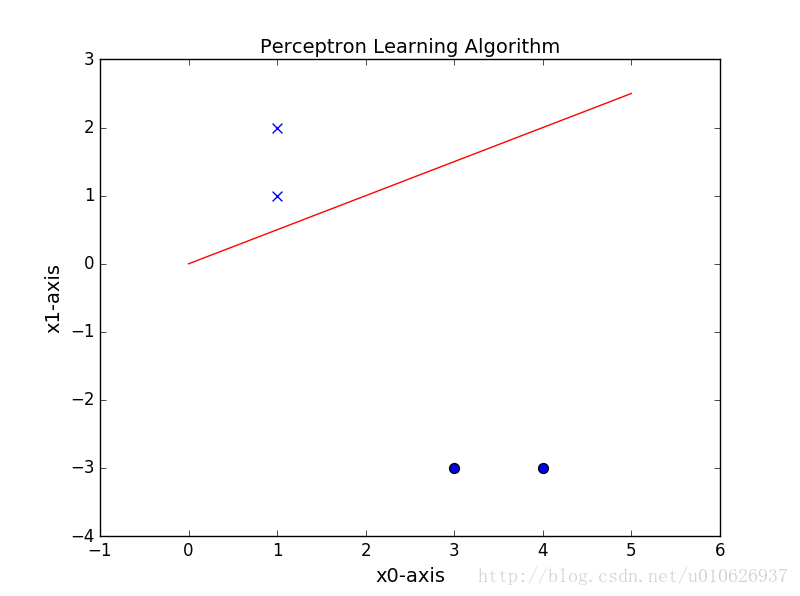
|
1
2
3
4
5
6
7
8
9
10
11
12
13
14
15
16
17
18
19
20
21
22
23
24
25
26
27
28
29
30
31
32
33
34
35
36
37
38
39
40
41
42
43
44
45
46
47
48
49
50
51
52
53
54
55
56
57
58
59
60
61
62
63
64
65
66
67
68
69
70
71
72
73
74
75
76
77
78
79
80
81
82
83
84
85
86
87
88
89
90
91
92
93
94
95
96
97
98
99
100
|
#利用Python实现感知机算法的对偶形式# -*- encoding:utf-8 -*-"""Created on 2017.6.7@author: Ada"""import numpy as npimport matplotlib.pyplot as plt#1、创建数据集def createdata(): samples=np.array([[3,-3],[4,-3],[1,1],[1,2]]) labels=np.array([-1,-1,1,1]) return samples,labels#训练感知机模型class Perceptron: def __init__(self,x,y,a=1): self.x=x self.y=y self.w=np.zeros((1,x.shape[0])) self.b=0 self.a=1#学习率 self.numsamples=self.x.shape[0] self.numfeatures=self.x.shape[1] self.gMatrix=self.cal_gram(self.x) def cal_gram(self,x): gMatrix=np.zeros((self.numsamples,self.numsamples)) for i in xrange(self.numsamples): for j in xrange(self.numsamples): gMatrix[i][j]=np.dot(self.x[i,:],self.x[j,:]) return gMatrix def sign(self,w,b,key): y=np.dot(w*self.y,self.gMatrix[:,key])+b return int(y) def update(self,i): self.w[i,]=self.w[i,]+self.a self.b=self.b+self.y[i]*self.a def cal_w(self): w=np.dot(self.w*self.y,self.x) return w def train(self): isFind=False while not isFind: count=0 for i in range(self.numsamples): tmpY=self.sign(self.w,self.b,i) if tmpY*self.y[i]<=0:#如果是一个误分类实例点 print '误分类点为:',self.x[i,:],'此时的w和b为:',self.cal_w(),',',self.b count+=1 self.update(i) if count==0: print '最终训练得到的w和b为:',self.cal_w(),',',self.b isFind=True weights=self.cal_w() return weights,self.b#画图描绘class Picture: def __init__(self,data,w,b): self.b=b self.w=w plt.figure(1) plt.title('Perceptron Learning Algorithm',size=14) plt.xlabel('x0-axis',size=14) plt.ylabel('x1-axis',size=14) xData=np.linspace(0,5,100) yData=self.expression(xData) plt.plot(xData,yData,color='r',label='sample data') plt.scatter(data[0][0],data[0][1],s=50) plt.scatter(data[1][0],data[1][1],s=50) plt.scatter(data[2][0],data[2][1],s=50,marker='x') plt.scatter(data[3][0],data[3][1],s=50,marker='x') plt.savefig('2d.png',dpi=75) def expression(self,x): y=(-self.b-self.w[:,0]*x)/self.w[:,1] return y def Show(self): plt.show()if __name__ == '__main__': samples,labels=createdata() myperceptron=Perceptron(x=samples,y=labels) weights,bias=myperceptron.train() Picture=Picture(samples,weights,bias) Picture.Show() |
实验结果:
误分类点为: [ 3 -3] 此时的w和b为: [[ 0. 0.]] , 0
最终训练得到的w和b为: [[-5. 9.]] , -1
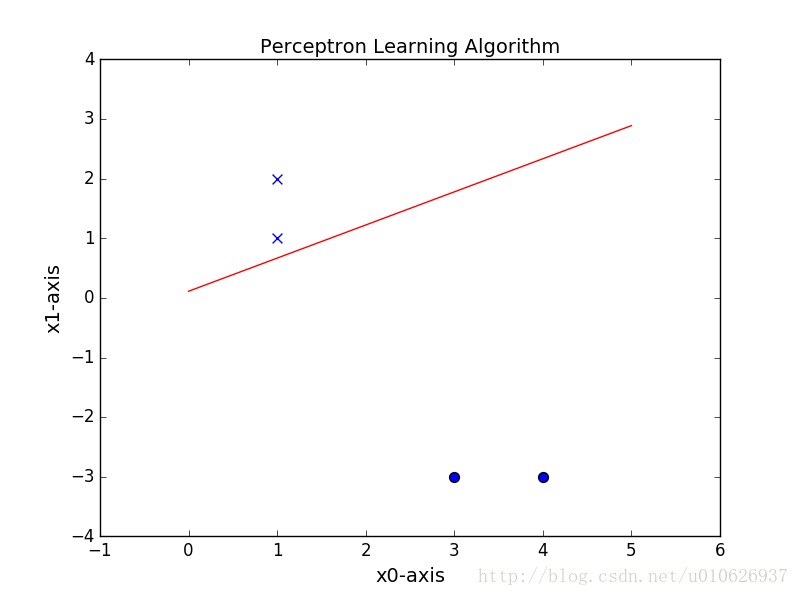
通过以上实验结果可以看出,两种方法的结果是不同的,一方面,是由于两种优化方法不同;二是,因为在选择实例点的顺序上有关系。但是无论用哪种方法,都可以找到一条直线,把数据完全分开。实际上,就算使用同一算法,如果改变初始值w0,b0,或者改变选择实例点的顺序,也可以使得结果不同。
算法二
Python的机器学习包sklearn中也包含了感知机学习算法,我们可以直接调用,因为感知机算法属于线性模型,所以从sklearn.linear_model中import下面给出例子。
|
1
2
3
4
5
6
7
8
9
10
11
12
13
14
15
16
17
18
19
20
21
22
23
24
25
26
27
28
29
30
31
32
33
34
35
36
37
38
39
40
41
42
43
44
45
46
47
48
49
50
51
52
53
54
55
56
57
58
59
60
61
62
63
64
65
66
67
68
|
# -*- encoding:utf-8 -*-"""利用sklearn中的感知机学习算法进行实验Created on 2017.6.7@author: Ada"""import numpy as npimport matplotlib.pyplot as pltfrom sklearn.linear_model import Perceptron#创建数据,直接定义数据列表def creatdata1(): samples=np.array([[3,-3],[4,-3],[1,1],[1,2]]) labels=np.array([-1,-1,1,1]) return samples,labelsdef MyPerceptron(samples,labels): #定义感知机 clf=Perceptron(fit_intercept=True,n_iter=30,shuffle=False) #训练感知机 clf.fit(samples,labels) #得到权重矩阵 weigths=clf.coef_ #得到截距bisa bias=clf.intercept_ return weigths,bias#画图描绘class Picture: def __init__(self,data,w,b): self.b=b self.w=w plt.figure(1) plt.title('Perceptron Learning Algorithm',size=14) plt.xlabel('x0-axis',size=14) plt.ylabel('x1-axis',size=14) xData=np.linspace(0,5,100) yData=self.expression(xData) plt.plot(xData,yData,color='r',label='sample data') plt.scatter(data[0][0],data[0][1],s=50) plt.scatter(data[1][0],data[1][1],s=50) plt.scatter(data[2][0],data[2][1],s=50,marker='x') plt.scatter(data[3][0],data[3][1],s=50,marker='x') plt.savefig('3d.png',dpi=75) def expression(self,x): y=(-self.b-self.w[:,0]*x)/self.w[:,1] return y def Show(self): plt.show()if __name__ == '__main__': samples,labels=creatdata1() weights,bias=MyPerceptron(samples,labels) print '最终训练得到的w和b为:',weights,',',bias Picture=Picture(samples,weights,bias) Picture.Show() |
实验结果:
最终训练得到的w和b为: [[-2. 4.]] , [ 0.]
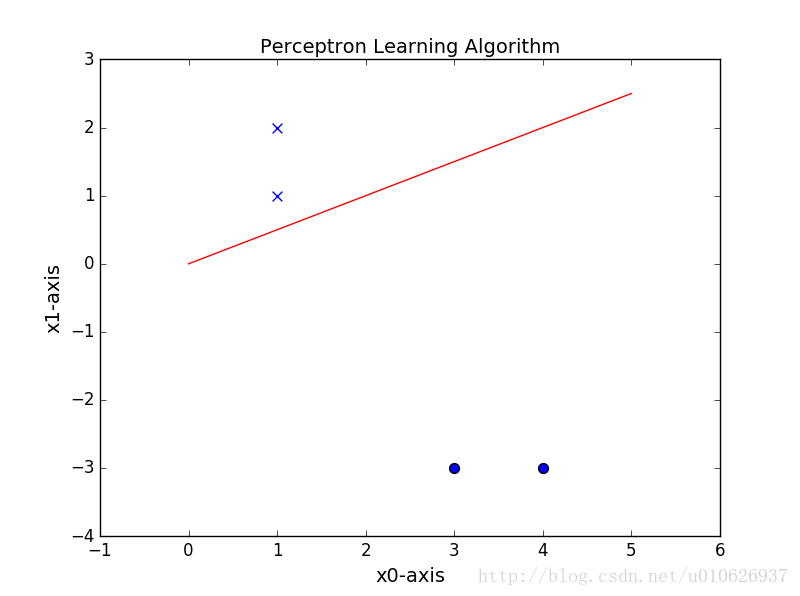
算法三
利用sklearn包中的感知器算法,并进行测试与评估
|
1
2
3
4
5
6
7
8
9
10
11
12
13
14
15
16
17
18
19
20
21
22
23
24
25
26
27
28
29
30
31
32
33
34
35
36
37
38
39
40
41
42
43
44
45
46
47
48
49
50
51
52
53
54
55
56
57
58
59
60
61
62
63
64
65
66
|
# -*- encoding:utf-8 -*-'''利用sklearn中的的Perceptron进行实验,并进行测试'''from sklearn.datasets import make_classificationfrom sklearn.linear_model import Perceptronfrom sklearn.cross_validation import train_test_splitfrom matplotlib import pyplot as pltimport numpy as np#利用算法进行创建数据集def creatdata(): x,y = make_classification(n_samples=1000, n_features=2,n_redundant=0,n_informative=1,n_clusters_per_class=1) ''' #n_samples:生成样本的数量 #n_features=2:生成样本的特征数,特征数=n_informative() + n_redundant + n_repeated #n_informative:多信息特征的个数 #n_redundant:冗余信息,informative特征的随机线性组合 #n_clusters_per_class :某一个类别是由几个cluster构成的 make_calssification默认生成二分类的样本,上面的代码中,x代表生成的样本空间(特征空间) y代表了生成的样本类别,使用1和0分别表示正例和反例 y=[0 0 0 1 0 1 1 1... 1 0 0 1 1 0] ''' return x,yif __name__ == '__main__': x,y=creatdata() #将生成的样本分为训练数据和测试数据,并将其中的正例和反例分开 x_train,x_test,y_train,y_test=train_test_split(x,y,test_size=0.2,random_state=0) #正例和反例 positive_x1=[x[i,0]for i in range(len(y)) if y[i]==1] positive_x2=[x[i,1]for i in range(len(y)) if y[i]==1] negetive_x1=[x[i,0]for i in range(len(y)) if y[i]==0] negetive_x2=[x[i,1]for i in range(len(y)) if y[i]==0] #定义感知机 clf=Perceptron(fit_intercept=True,n_iter=50,shuffle=False) # 使用训练数据进行训练 clf.fit(x_train,y_train) #得到训练结果,权重矩阵 weights=clf.coef_ #得到截距 bias=clf.intercept_ #到此时,我们已经得到了训练出的感知机模型参数,下面用测试数据对其进行验证 acc=clf.score(x_test,y_test)#Returns the mean accuracy on the given test data and labels. print '平均精确度为:%.2f'%(acc*100.0) #最后,我们将结果用图像显示出来,直观的看一下感知机的结果 #画出正例和反例的散点图 plt.scatter(positive_x1,positive_x2,c='red') plt.scatter(negetive_x1,negetive_x2,c='blue') #画出超平面(在本例中即是一条直线) line_x=np.arange(-4,4) line_y=line_x*(-weights[0][0]/weights[0][1])-bias plt.plot(line_x,line_y) plt.show() |
实验结果为:平均精确度为:96.00
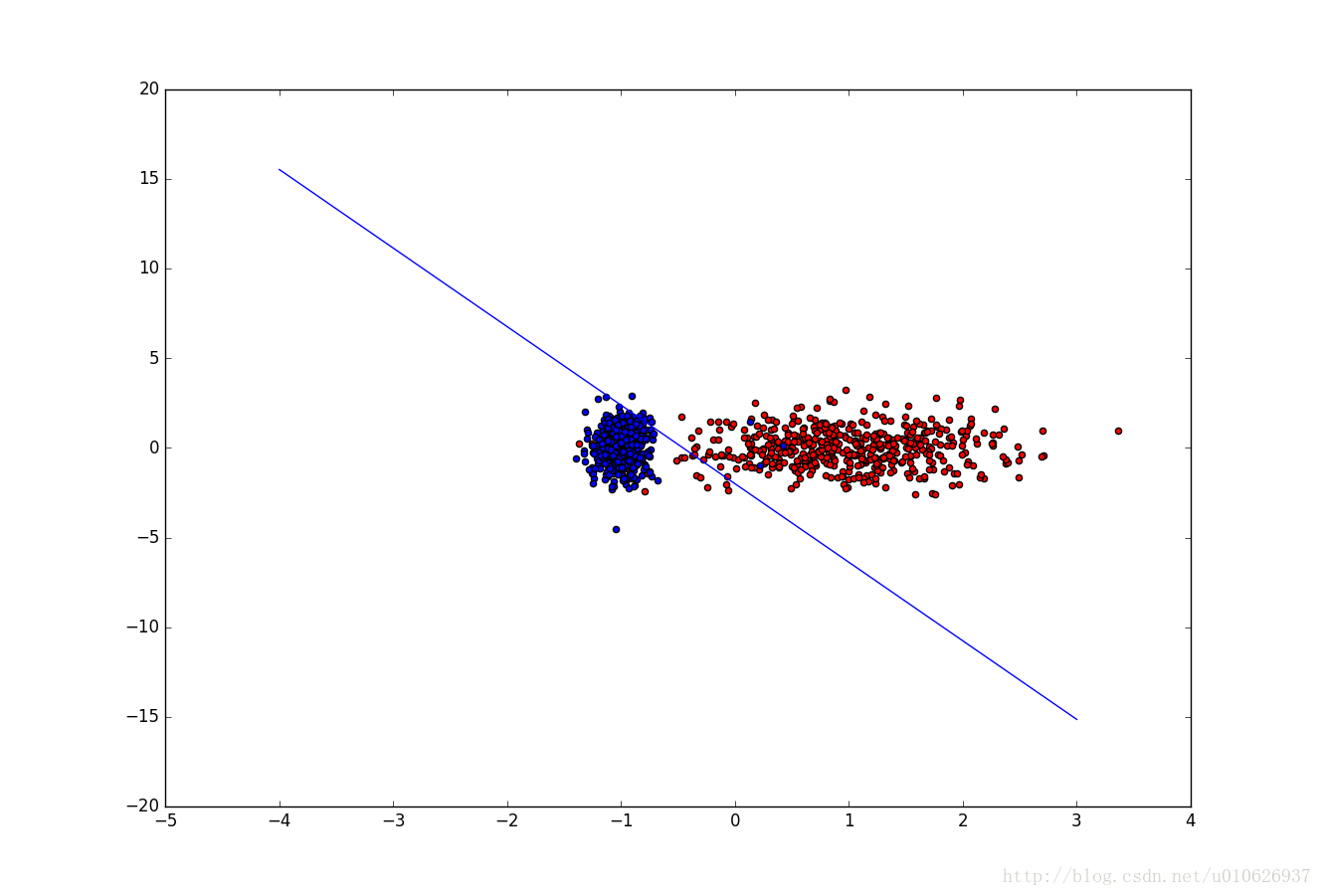
通过算法三和算法四可以看出,直接调用开源包里面的算法还是比较简单的,思路是通用的。
算法四
我们利用sklearn包中的感知机算法进行分类算法的实现。
|
1
2
3
4
5
6
7
8
9
10
11
12
13
14
15
16
17
18
19
20
21
22
23
24
25
26
27
28
29
30
31
32
33
34
35
36
37
38
39
40
41
42
43
44
45
46
47
48
49
50
51
52
53
54
55
56
57
58
59
60
61
62
63
64
65
66
67
68
69
70
71
72
73
74
75
76
77
78
79
80
81
82
83
84
85
86
87
88
89
90
91
92
93
94
95
96
97
98
99
100
101
102
103
104
105
106
107
108
109
|
# -*- encoding:utf-8 -*-import numpy as np'''以scikit-learn 中的perceptron为例介绍分类算法应用及其学习分类算法的五个步骤(1)选择特征(2)选择一个性能指标(3)选择一个分类器和一个优化算法(4)评价模型的性能(5)优化算法以scikit-learn 中的perceptron为例介绍分类算法1 读取数据-iris2 分配训练集和测试集3 标准化特征值4 训练感知器模型5 用训练好的模型进行预测6 计算性能指标7 描绘分类界面'''from sklearn import datasetsimport numpy as npimport matplotlib.pyplot as pltiris=datasets.load_iris()X=iris.data[:,[2,3]]y=iris.target#训练数据和测试数据分为7:3from sklearn.cross_validation import train_test_splitx_train,x_test,y_train,y_test=train_test_split(X,y,test_size=0.3,random_state=0)#标准化数据from sklearn.preprocessing import StandardScalersc=StandardScaler()sc.fit(x_train)x_train_std=sc.transform(x_train)x_test_std=sc.transform(x_test)#引入skleran 的Perceptron并进行训练from sklearn.linear_model import Perceptronppn=Perceptron(n_iter=40,eta0=0.01,random_state=0)ppn.fit(x_train_std,y_train)y_pred=ppn.predict(x_test_std)print '错误分类数:%d'%(y_test!=y_pred).sum()from sklearn.metrics import accuracy_scoreprint '准确率为:%.2f'%accuracy_score(y_test,y_pred)#绘制决策边界from matplotlib.colors import ListedColormapimport warningsdef versiontuple(v): return tuple(map(int,(v.split('.'))))def plot_decision_regions(X,y,classifier,test_idx=None,resolution=0.02): #设置标记点和颜色 markers=('s','x','o','^','v') colors=('red','blue','lightgreen','gray','cyan') cmap=ListedColormap(colors[:len(np.unique(y))]) # 绘制决策面 x1_min, x1_max = X[:, 0].min() - 1, X[:, 0].max() + 1 x2_min, x2_max = X[:, 1].min() - 1, X[:, 1].max() + 1 xx1, xx2 = np.meshgrid(np.arange(x1_min, x1_max, resolution), np.arange(x2_min, x2_max, resolution)) Z = classifier.predict(np.array([xx1.ravel(), xx2.ravel()]).T) Z = Z.reshape(xx1.shape) plt.contourf(xx1, xx2, Z, alpha=0.4, cmap=cmap) plt.xlim(xx1.min(), xx1.max()) plt.ylim(xx2.min(), xx2.max()) for idx, cl in enumerate(np.unique(y)): plt.scatter(x=X[y == cl, 0], y=X[y == cl, 1], alpha=0.8, c=cmap(idx), marker=markers[idx], label=cl) if test_idx: # 绘制所有数据点 if not versiontuple(np.__version__) >= versiontuple('1.9.0'): X_test, y_test = X[list(test_idx), :], y[list(test_idx)] warnings.warn('Please update to NumPy 1.9.0 or newer') else: X_test, y_test = X[test_idx, :], y[test_idx] plt.scatter(X_test[:, 0], X_test[:, 1], c='', alpha=1.0, linewidth=1, marker='o', s=55, label='test set')def plot_result(): X_combined_std = np.vstack((x_train_std, x_test_std)) y_combined = np.hstack((y_train, y_test)) plot_decision_regions(X=X_combined_std, y=y_combined, classifier=ppn, test_idx=range(105,150)) plt.xlabel('petal length [standardized]') plt.ylabel('petal width [standardized]') plt.legend(loc='upper left') plt.tight_layout() plt.show()plot_result() |
实验结果为:错误分类数:4;准确率为:0.91
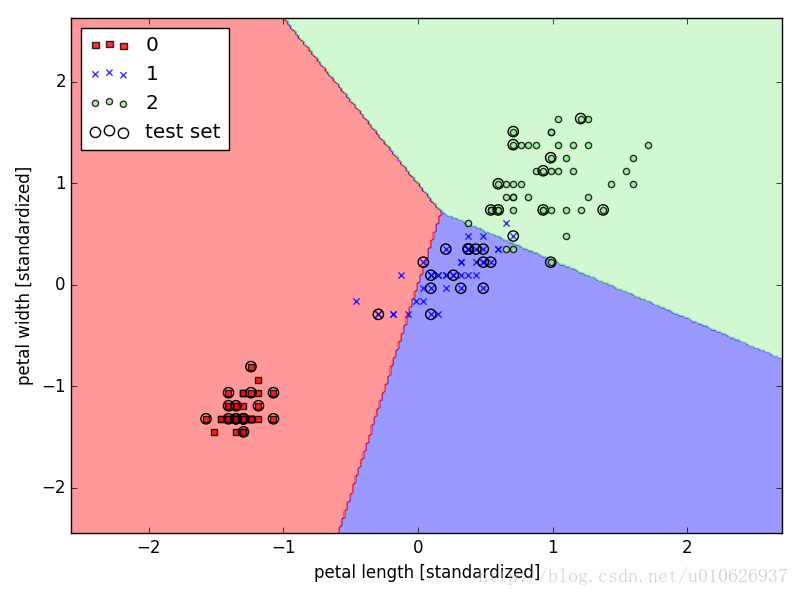
<完>
以上就是本文的全部内容,希望对大家的学习有所帮助,也希望大家多多支持服务器之家。
原文链接:http://blog.csdn.net/u010626937/article/details/72896144#算法一










